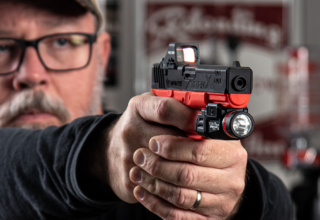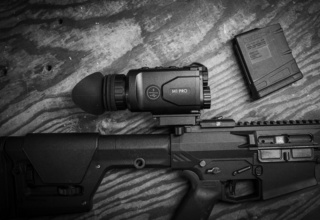There are many things to consider when looking to improve your defensive handgun skills and raising your personal level of “qualification” — here are a few…
by Bob Campbell
I cannot recall how many times a pundit — even those who should know better — has criticized the police qualification course. Some call it a mindless exercise. Perhaps I felt that way after twenty years or so of the same course. But don’t knock what you have not tried. As a civilian with the public safety mindset, I continue to train, train others, and to remain sharp. This sharpness is balanced against the reality of daily work, recreation, and enjoying semi-retirement. I also engage in the occasional “free shooting” and simply chasing accuracy. If we carry a concealed handgun or keep a handgun ready for home defense, we must have a degree of competency. Not necessarily to win 3-gun matches, but enough accuracy to defend the home, family, and person.
Most types of shooting really don’t increase your skill level. And that is what it is all about: improving accuracy and speed and finding the right balance. In training, you will have to maintain a certain criteria, including speed management, measuring improvement, and eliminating misses. You cannot call the bullet back, and making hits and eliminating misses are the same thing. Each is of equal importance. The best way to measure improvement or learn if skills have degraded is to find a good qualification course, even if you design it yourself, and run it every three months or so. In the meantime, spend time building skills such as trigger press, sight alignment, sight picture, recoil control, and follow-through. Then, combine these skills in a qualification course, as in a course of fire.
Don’t design an easy course!
During my time in uniform, I cannot recall a period when I did not fire and practice at least once a week — sometimes more often. I also engaged in competition. A couple of fellows practiced more and won more events. The majority did not. About half of the officers found their way to the range a week or so before qualification and fired in a stressful blur of activity to somehow prepare. Despite this wide divergence in practice time, all usually qualified the first round to a passing standard; a few had to fire again. The difference between the best shots and the median was not as pronounced as you may think, but the best were good…very good.

We qualified at 50 yards in those days. An officer firing a four-inch barrel Model 66 revolver would place six shots in the K-zone of a man-sized target at 50 yards. I believe the time allowed was twenty seconds. These men would have dropped an active shooter or spree shooter if any were around. One officer did rain lead into a window frame at 50 yards and convinced a rifle-armed shooter to give up during a domestic situation. The wife had been wounded in what we used to call a Smith & Wesson divorce.
Qualification was often every six months. A very few agencies qualified on a yearly basis and far less every four months. There were many courses that you must take, including driving schools, accident reconstruction, blood splatter, preserving the crime scene, public speaking, and later, airborne pathogens. Not that qualification wasn’t important, but the preparation and expense were more than classroom time and not quite as enjoyable as high-speed driving courses. Why advanced courses for the rank and file? Many, many important cases were solved by the diligence of a field officer in preserving evidence.
Back to qualifications. Sure, the firing course may become easy for a skilled shooter.

There has been a trend toward qualifications with the longest range being 15 instead of 25 yards. That’s ok in a manner of speaking, but not ok in others. We don’t want to be helpless if a spree shooter is beyond our comfort zone. As one officer shooting beside me pointed out a few weeks ago, his agency has not had to fire beyond 15 yards in 20 years of shootings he has studied. This would probably be true in most studies. Longer-range fire, though, points out any short comings in your grip, sight picture, and trigger press. On that basis alone, long-range fire is worthwhile to study and practice. You may make one ragged hole at 7 yards in unlimited firing but that doesn’t mean you are a good shot. Stretch the distance from time to time.
It goes without saying that you must improve your weakest skill while working to maintain your strongest. It isn’t like boxing, where a hook or jab is your advantage. In shooting, you don’t know what your advantage may be or whether short- or long-range shooting will be needed. We have only a median to study. Since my non-dominant arm has been injured twice and will never be as strong as my strong-side arm, weak-hand fire is more of a struggle. So be it. I work hard to improve my scores.
Since violent criminals do not behave in a gentlemanly fashion and now seem to travel in gangs, you should address multiple targets. Placing three targets at 5 yards and then moving them back to 7 is a good part of a shooting course.

One of my shooting friends is a tall, thin, flamingo-on-stilts who has had an interesting career. Recently, as we rushed through an overpriced tasteless meal, we had a good discussion on training, qualification, and where to find a good price on Tums. When dealing with the self-destructive elements of society, we must practice hard. This means, Dan says, to practice beyond the bounds of our own competence. Qualification is an exhibition of our competence. We must go beyond the previous performance.

Another friend, Ron, a former fire chief, enjoyed a distinguished career until a burning beam fell on his back and cut his chosen occupation short. In his field, he looked for dry spots where an arsonist found easy kindling. I looked for hot spots and easy hiding places. We each were able to admit that we have had experiences in which our knees beat not to a discernible rhythm but an adrenaline overload. Some of our work involved highways, but most of my service was in more circumscribed areas and the range in both personal incidents and investigated shooting incidents was short. We agreed that practicing beyond the boundaries of competence is a task that many are unwilling to perform.
Realism is good up to a point. As an example, a trainer in my early days told us to fire every once in a while without hearing protection. (WHAT?!?!?!?) He said we would not have earmuffs on the street. Well, the Chief had a word with him before any of us herniated our tympanic membranes. You won’t have knee pads on a street corner, either, but they are a very good thing to have when firing from kneeling positions and working around cover. It depends on if the range is grass lined or concrete, I guess.

I have modified my qualifications to make them true qualifications and a true measure of what I am capable of. First, it is essential that you shoot the course cold. Don’t warm up by firing a few magazines. Go to the range, set up, and fire. That’s it. Pass or fail. Record performance and work on the poorest part of the test. If you have a shot outside the paper, you have failed the course. Nope, no passing grade if most of the shots are in the target yet that single wild shot fails you. The shots should be centered, and you should have solid hits. If you miss the entire target, you are a dangerous person with a gun…and not in a formidable way.
Here is a sample of my qualification I fired in order not to just keep the edge but to also qualify the quality of the practice I have undertaken. Often enough, I may add a “speed rock.” Sometimes I fire at a low-lying grounded target when practicing animal defense. This qualifier will prove to be a test of the best of us. In all cases, be certain to practice with the gun you carry and to draw from concealed carry.
The following course will take 60 rounds of ammunition.
Three yards, maximum speed
- Five rounds in five seconds; one hand.
Three yards, weak hand
- Five rounds in five seconds.
Five yards
- Five rounds in five seconds; one hand shoulder point using sights.
Five yards
- Weak hand; five rounds in five seconds; one hand shoulder point using sights.
Seven yards
- Two hands; five rounds in five seconds.
Seven yards
- Failure to stop drill; three rounds in chest, two rounds in pelvis or cranio ocular vault.
- Repeat this drill
Ten yards
- Five rounds in ten seconds after drawing and making first hit in 1.5 seconds.
- Repeat this drill
Fifteen yards
- Five rounds in five seconds; two hands.
Twenty-five yards
- Draw; move to cover; fire five rounds in ten seconds.
Twenty-five yards
- Draw; move to kneeling cover; five rounds in ten seconds

If you have access to a steel gong, there is nothing better for practice. Center-punch the gong and it flies back. Hit to one side or the other, or low, and feedback is obvious. Miss and you have a red face and must practice harder. Be safe and don’t get too close to the gongs so you will avoid back-splatter.

















